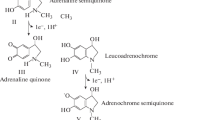Abstract
The catalase inhibitor 3-amino-1,2,4-triazole causes an increase in dopamine-β-hydroxylase (DBH) activity, as do other nitrogen-containing heterocyclics. Denatured catalase also causes an increase in activity, but in both cases, optimum activity is attained only in the presence of some native catalase. It is proposed that the latter affects the DBH reaction in two different ways: It decomposes toxic peroxides, and it stabilizes the enzyme in some manner as yet unknown, as do the heterocyclics. The nitrogen-containing compounds, and denatured catalase, protect DBH from inhibition by copper. Ideas concerning the relationships of copper, catalase, and DBH must be altered to accommodate these new data.
Similar content being viewed by others
References
Brown, F. C., andHarralson, J. D. (1975) Observations on the properties of dopamine-β-hydroxylase. J. Neurochem. 24, 467–470.
Levin, E. Y., andKaufman, S. (1961) Studies on the enzyme catalyzing the conversion of 3,4-dihydroxyphenylethylamine to norepinephrine. J. Biol. Chem. 236, 2043–2049.
Goldstein, M., Lauber, E., andMcKereghan, M. R. (1965) Studies on the purification and characterization of 3,4-dehydroxyphenylethylamineβ-hydroxylase. J. Biol. Chem. 240, 2066–2072.
Foldes, A., Feffrey, P. L., Preston, B. N., andAustin, L. (1972) Dopamine-β-hydroxylase of bovine adrenal medulla. Biochem. J. 126, 1209–1217.
Margoliash, E., Novogrodsky, A., andSchejter, A. (1960) Irreversible reaction of 3-amino-1,2,4-triazole and related inhibitors with the protein of catalase. Biochem. J. 74, 339–348.
Friedman, S., andKaufman, S. (1965) 3,4-Dihydroxyphenylethylamine-2,β-hydroxylase. J. Biol. Chem. 240, 4763–4773.
Aunis, D., Miras-Portugal, M. T., andMandel, P. (1973) Bovine adrenal medullary dopamine-β-hydroxylase: Purification by affinity chromatography, kinetic studies, and presence of essential histidyl residues. Biochim. Biophys. Acta 327, 313–327.
Hemmerich, P. (1966) Model studies on the binding of univalent and redox-active copper in proteins,in Peisach, J., Aisen, P., andBlumberg, W. F. (eds.), The Biochemistry of Copper. Academic Press, New York, pp. 15–34.
Author information
Authors and Affiliations
Additional information
This study was supported in part by United States Public Health Service Grant NS-04454. A preliminary report of these experiments was presented at a Symposium on New First and Second Messengers in Nervous Tissues in Brescia, Italy, August 28–30, 1975.
Rights and permissions
About this article
Cite this article
Brown, F.C., Harralson, J.D. Dopamine-β-hydroxylase: Stimulation by nitrogen-containing heterocyclics and the role of catalase. Neurochem Res 1, 337–347 (1976). https://doi.org/10.1007/BF00973778
Accepted:
Issue Date:
DOI: https://doi.org/10.1007/BF00973778




